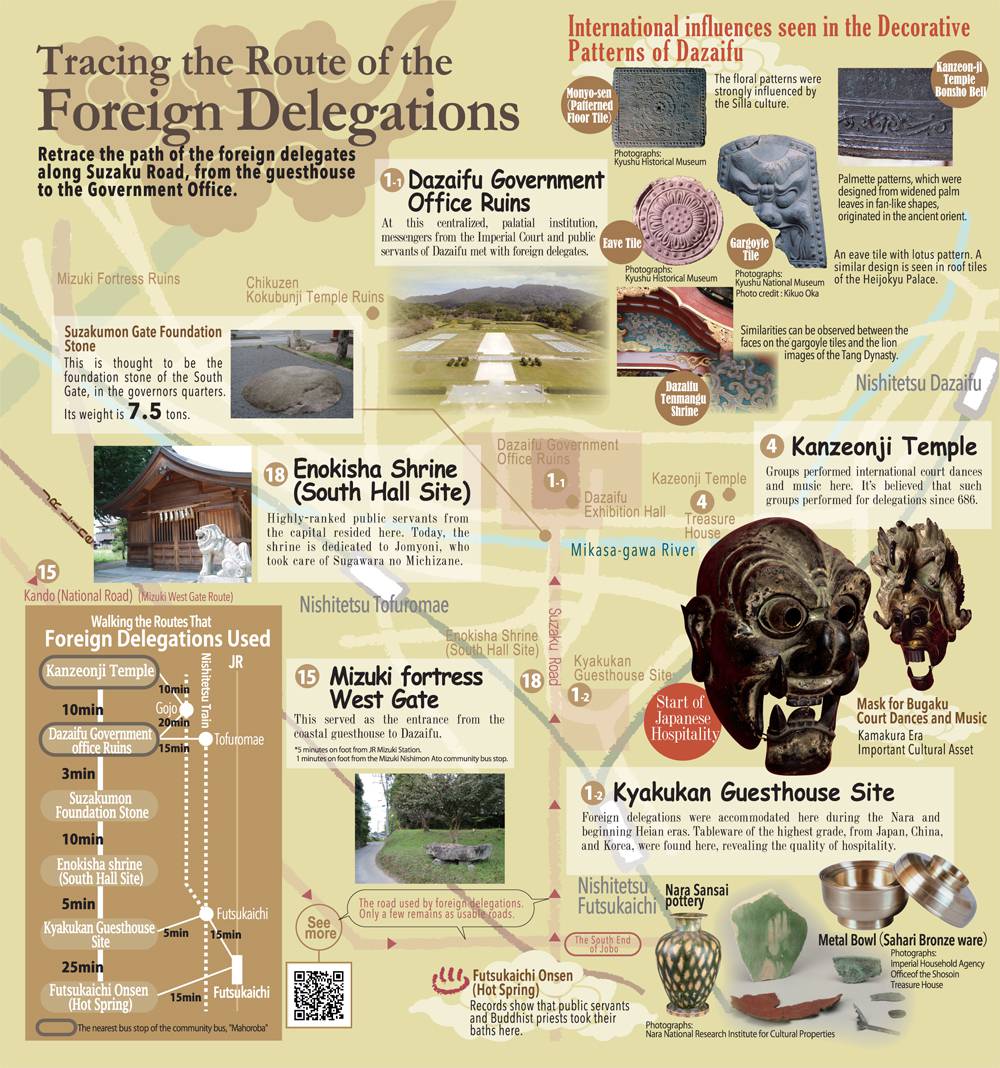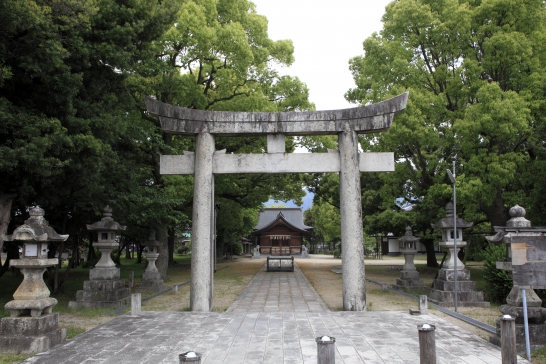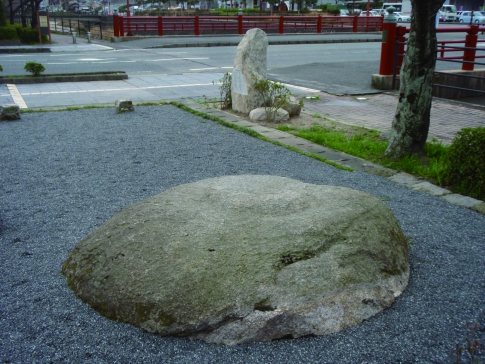
Tracing the Route of the Foreign Delegations

Let us pretend to be foreign delegates and trace Suzaku Avenue between Site of Kyaku-kan (The Guesthouse) and the Government Office!
-
Ruins of Kyaku-kan(The Guest House)
Kyaku-kan (The Guesthouse) was a facility for foreign delegates to stay while they were in Dazaifu.
Just like other capitals in East Asia, it was located alongside the main road (Suzaku Road or Central South to North Avenue) leading out of the Government Office.
This is where diplomacy was conducted vigorously from the 8th century to the early 9th century. As a result of the investigation of these ancient sites, ruins of huge buildings along with the highest quality of tableware from the Tang and Silla dynasties, as well as from Japan, were found in Kyaku-kan (The Guesthouse). Tea bowls used for a tea-drinking custom that started in the Tang dynasty were also found at the site. -

Enoki-sha Shrine
This shrine is located on the west side of Suzaku Road which continued from the center of Dazaifu Government Office.
This site of South Hall was the official residence for public officials who were assigned from the Imperial Court there and it is known as a residence of Sugawara no Michizane.
The building in the center of the main shrine is called “Otabi-sho”. It is the place where Michizane’s spirit stays one night during the Jinko Festival. Behind this building, there is a small shrine called “Jomyo-ni Hokora” for Jomyoni who took care of Michizane and also there is a memorial service tower for one of Michizane’s children Beni-hime. -

Foundation Stone of Suzaku-mon Gate
This place is 230-meters due south from the south gate of the Government Offices. Foundation stones were found in the riverbed of Mikasa River running in front of this place in the year 1982. Judging by its location, it has been considered that these foundation stones were for “Suzaku-mon Gate”, main gate of the south, to go into the Government office.
South of this location there was the main road, Suzaku Road, with a width of 36-meters leading to the Government office. At both sides there was “Dazaifu Jobo” (grid based city) which the city built on a grid of 90 square meter sections. There were 22 sections (Jo) from South to North, 20 sections (Bo) from East to West and it measured about 2km wide. -
Ruins of the Dazaifu Government Office
This Government Office is the center of Dazaifu. This structure is similar to the palace of the capital.
Going up the stairs from the south side leads to “Site of South Gate”. Inside was surrounded by walls. If you keep going you will reach “Site of Central Gate”. If you keep going farther it takes you to a wide garden (space) surrounded by a corridor continuing from the Central Gate. This may be a place for government affairs, ceremonies or sometimes for diplomatic protocols.
The elevated area at the center (center of North) is “Ruins of Seiden (main building)”. Each of two “Ruins of Wakiden” are located in each East and West side of the garden.
At the back of Seiden, there is a “Ruin of Kouden (back building)”. This is considered as the place where Sochi (Governor of Dazaifu) went about his duties.
Next, let’s see the surrounding ruins of the Government Office.
“Ono-jo” fortress is located on the top of a mountain in the North, and “Kii-jo” fortress is located on the top of a mountain to the south. Both mountain fortresses were built in 665 and protected as the outer walls of “The Western Capital” Dazaifu.
To the east, on “Tsukiyama” hill, it has been said that a water clock was placed to tell the hour.
To the west, on “Kura-no-tsukasa” hill, huge ruins of foundation stones still remain.
In the south area, there were Government offices.In front of them there was Suzaku-mon Gate. From there Suzaku Road(or South to North Road) was extended leading to the ancient town. -
Dazaifu Exhibition Hall
This facility is preserving and exhibiting remaining ditches found during the investigation of the site. It explains the history of Dazaifu and displays the excavated articles.
You can enjoy a reconstructed model of the Dazaifu Government Office, a diorama of a “Plum-Blossom Party” by Hakata puppeteers and ancient traditional Japanese cuisine.
There are experienced volunteers on hand to explain the historical sites and take you on a tour of the city.No fee is required / Open from 9:00a.m to 4:30p.m.
Notification: The fee will be charged from July 2, 2019 (Tuesday).
Entrance fee:
Adult 200 yen,
High school and university students 100 yen,
Free: Junior high school students and belowClosed on Mondays and during the end of the year and new year holidays (December 28th to January 4th)
When Monday is a national holiday or a substitute holiday the next day will be closed.
TEL 092-922-7811
URL http://www.kotodazaifu.net/index.htmlDazaifu Exhibition Hall
This facility is preserving and exhibiting remaining ditches found during the investigation of the site. It explains the history of Dazaifu and displays the excavated articles.
You can enjoy a reconstructed model of the Dazaifu Government Office, a diorama of a “Plum-Blossom Party” by Hakata puppeteers and ancient traditional Japanese cuisine.
There are experienced volunteers on hand to explain the historical sites and take you on a tour of the city.No fee is required / Open from 9:00a.m to 4:30p.m.
Notification: The fee will be charged from July 2, 2019 (Tuesday).
Entrance fee:
Adult 200 yen,
High school and university students 100 yen,
Free: Junior high school students and belowClosed on Mondays and during the end of the year and new year holidays (December 28th to January 4th)
When Monday is a national holiday or a substitute holiday the next day will be closed.
TEL 092-922-7811
URL http://www.kotodazaifu.net/index.htmlSee all -
Kanzeon-ji Temple
Empress Saimei headed to Baekje (One of the three kingdoms of ancient Korea which ceased to exist in the year 660) to restore it. However, she died in Tsukushi (Fukuoka) in the year 661.
Kanzeon-ji Temple was built on the wish of her son, Emperor Tenji in memory of her. It took about 80 years to complete and held a memorial service for the finished Garan (a complex of temple buildings) in the year 746. In 761, “Kaidan-in” was also built for delivering the commandments of Buddhism.
Kanzeon-ji Temple was called “Fu-no-odera (A Large Temple of the Province)” and it was the top Buddhism temple in Kyushu.










